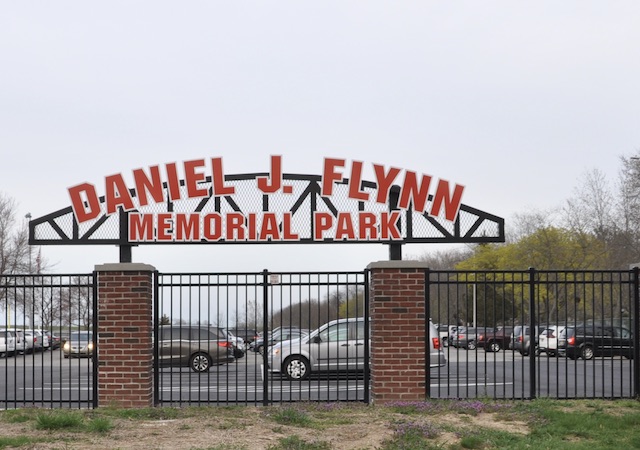News of Long Ago - Gouras Family A History Of Hard Work And Snow Storm Of '34
 Tuesday, March 4, 2014 at 8:54PM
Tuesday, March 4, 2014 at 8:54PM News of Long Ago by Bradley Harris, Smithtown Historian
(This article is about the Gouras family and the fur shop they owned and operated on Main Street in Smithtown Branch from 1924 until 1988. The information contained in this article came from conversations with Jim Gouras, George Arns, Lee Corbani, Tom Hancock, Walter Macheck, Earl Scott, and Pete Vitale.)
“The Gouras family of Smithtown Branch….”
The Gouras family has been a part of the Smithtown Branch community since 1923, the year that Sotir and Anastasia Gouras moved out of New York City and came to Smithtown Branch. Sotir and Anastasia Gouras were Greek immigrants who came to America seeking a better life and found it in Smithtown. Their children were all born in America, and two of them were born in Smithtown. Smithtown became their home and it still is for James Gouras, who with his wife Estelle, lives on Elm Avenue not far from his boyhood home on Main Street. James has lived all his life in Smithtown and with the passage of time, he has become the patriarch of the Gouras family. Today he happily presides over an extended family that includes his two daughters Christina and Diana, their husbands, and three grandchildren. The Gouras family story is unique because the Gourases were one of the first Greek families to live in Smithtown Branch and their lives became interwoven with the fabric of the history of the town itself.
Jim & Estelle Gouras photo published in Smithtown News
The Gouras family story begins long ago in a little town in northern Greece, a town that both Anna and Sotir called home. Sotir was born in Athens, Greece in 1891. Anastasia was born in 1892 in the little mountain village of Siatista in Macedonia. Sotir spent his childhood in Athens, but he was orphaned when he was just a little boy of ten and became a ward of the Greek Orthodox Church. Eventually he struck out on his own and found his way north to the same little village where Anastasia lived. Here Sotir began to work in the fur industry. By the time he was in his twenties, Sotir owned a fur shop and a beautiful girl named Anastasia came to work in his shop. It was also at this time that Sotir became a guerrilla fighter in the mountains of Macedonia where Greek partisans waged war on the Turks who were occupying Macedonia. Sotir must have been a fearless and fearsome fighter since he was awarded the Greek Victorian Cross for bravery. When the Balkan War came to an end in 1912, Sotir came out of the mountains and back to his shop and the girl he loved. But he soon found that his life was in danger from the Turks who lived in the area and were seeking revenge for their losses in the Balkan War. Sotir discovered that he was on a list, marked for death, and he had no choice but to get out of Greece. So he took all his furs, left Greece and Anastasia behind, and made his way to Leipzig, Germany, the fur center of Europe. There he sold his wares, bought a ticket to America, and landed on Ellis Island sometime in 1913.
 Jim Gouras (Gouras family photo)In 1913, Sotir was just twenty-two and pretty much on his own. He found living quarters on 24th St. just off 6th Avenue, close to the fur district. He looked for work as a furrier, but he couldn’t find work in the fur business and went to work as an oven-man for the National Biscuit Company. It was brutally hot work and Sotir lost a lot of weight tending the ovens. But by 1914, Sotir was able to quit working for the National Biscuit Company and opened his own fur shop at 138 Seventh Avenue, between 18th and 19th Streets. Sotir advertised as a “Manufacturer of Furs” and he must have made some money, since he asked Anna to join him in America in 1916. Anna was twenty-five at the time, and she set out on a journey that took her half- way around the world, to a new home where people spoke a strange language, and followed a way of life that was completely foreign to Anastasia. Yet Anna swallowed her fear, boarded an ocean liner, and made her lonely way across the Atlantic. It must have been quite a frightening experience, but at least, when she arrived at Ellis Island, Sotir was there to greet her.
Jim Gouras (Gouras family photo)In 1913, Sotir was just twenty-two and pretty much on his own. He found living quarters on 24th St. just off 6th Avenue, close to the fur district. He looked for work as a furrier, but he couldn’t find work in the fur business and went to work as an oven-man for the National Biscuit Company. It was brutally hot work and Sotir lost a lot of weight tending the ovens. But by 1914, Sotir was able to quit working for the National Biscuit Company and opened his own fur shop at 138 Seventh Avenue, between 18th and 19th Streets. Sotir advertised as a “Manufacturer of Furs” and he must have made some money, since he asked Anna to join him in America in 1916. Anna was twenty-five at the time, and she set out on a journey that took her half- way around the world, to a new home where people spoke a strange language, and followed a way of life that was completely foreign to Anastasia. Yet Anna swallowed her fear, boarded an ocean liner, and made her lonely way across the Atlantic. It must have been quite a frightening experience, but at least, when she arrived at Ellis Island, Sotir was there to greet her.
Sotir and Anna were married in 1916 in the Greek Orthodox Cathedral on 72nd Street in Manhattan. Sotir opened a new fur shop at 309 West 37th Street and this became their home. In the fur shop the couple pieced skins together to create “fur plates” that were 48” by 96” and they sold these plates to fur coat manufacturers. A coat could be made from one of these plates of beautifully matched pelts. In 1917, Anna and Sotir were blessed when a baby girl named Alexandra came into their life. Her arrival was followed in 1920 by the birth of a son named James. The Gouras family was prospering and growing and becoming acclimated to life in a new country. Sotir decided to become an American citizen, and on Dec. 4, 1922, he became a naturalized citizen. (It would be many years before Anna became an American citizen, but she finally did so in 1962 when she was living in apartment behind the fur shop in Smithtown.)
In 1922, Sotir Gouras made a decision to move out of New York City. He and his wife, Anastasia, and their two children, were in the area on the west side of Manhattan that was known as the fur district and it was very close to a tough neighborhood known as Hell’s Kitchen. Anastasia didn’t feel safe in the city, longed to live life in a little village, and wanted her children to experience life in the country. Sotir looked for a home he could afford, a town that was linked to New York City by railroad and was not too far to commute. Sotir first attempted to buy property in Hempstead, but that fell through, and then he bought land in Hauppauge. In 1923, Sotir brought his family to live on the five acres of woodland he purchased, sight unseen, on the east side of the road to Hauppauge (Route 111), just north of Bill Arns’ Garage. It took courage for the Gourases to leave New York City for the little country town of Smithtown Branch, and surely it must have been a shock for them when they discovered that the land they had purchased was five acres of woods off a dirt road that was in the middle of nowhere.
Sotir had some of the wooded property cleared so that he could have a house built on the land. George Arns remembered the house. It was two and a half stories with a sloping roof and a big dormer on the front. There was a porch that ran across the front of the house and this porch was enclosed in the wintertime. “It was a nice home, well-made and nicely landscaped. There was a garage in the back and further back on the property were sheds for the sheep that Mr. Gouras kept on his five acres.” Jim Gouras, who was born in 1927 in this house, remembered that the house had “small rooms, a bathroom with a tile floor composed of small white octagonal tiles, and a bath tub that had a ring suspended over it for a shower curtain. There was a coal stove in the kitchen, a coal furnace in the basement, interior plumbing, and we had electric lights, although we still had kerosene lamps in the house for emergencies.”
When Sotir and Anna moved into their new home, Sotir ran his fur business out of the house. Sotir would buy fur pelts by the bundle in New York City, bring the bundles out to the house in Hauppauge, where he and Anna would sew the furs together to make plates, and then take the plates back into New York City to sell to fur coat manufacturers. Sotir made enough money doing this that he could afford to open his own fur shop on Main Street in Smithtown Branch. He rented the store that used to be Johnny’s Subside and hung out a sign announcing that this was the shop of Sotir Gouras, “Manufacturer of Furs.” Everyone laughed at the idea of a furrier setting up shop in Smithtown, but Sotir was determined that he would succeed. In the new shop, Anna and Sotir continued to make plates for the New York City market and kept them in the store. Unfortunately, the shop was not very secure and someone found out that they were keeping furs there and stole them. That theft led to Sotir’s decision to buy a piece of land on Main Street and build his own store that he could properly secure to protect his stock of furs.
 site of the former Gouras Fur Shop - The store on Main Street that Sotir Gouras had built in 1924. The Gouras fur shop occupied the east side of the shop where the ReMax Real Estate Office is now located and the west side of the shop has had a number of tenants and is presently occupied by the State Farm Insurance Company. In 1924, Sotir Gouras purchased a plot of land for $500 from Claude Conklin and had a store erected on the lot. It was a fairly large store and Sotir had it partitioned down the middle so that it could house two businesses. (The building is still standing and is today occupied by the State Farm Insurance Agency and the ReMax Real Estate Office.) Sotir moved his fur shop into the east side of the store and the west side of the store was rented to an open-air food market. The market was run by Corbani and Radau and was known as the Blue Jay Market. With tenants in his store, Sotir was able to make his mortgage payment. In 1927, a third store was partitioned off from the fur shop, and a shoemaker rented the space. So Sotir had income from his fur business and from the tenants who rented space in his building, and he was becoming financially secure.
site of the former Gouras Fur Shop - The store on Main Street that Sotir Gouras had built in 1924. The Gouras fur shop occupied the east side of the shop where the ReMax Real Estate Office is now located and the west side of the shop has had a number of tenants and is presently occupied by the State Farm Insurance Company. In 1924, Sotir Gouras purchased a plot of land for $500 from Claude Conklin and had a store erected on the lot. It was a fairly large store and Sotir had it partitioned down the middle so that it could house two businesses. (The building is still standing and is today occupied by the State Farm Insurance Agency and the ReMax Real Estate Office.) Sotir moved his fur shop into the east side of the store and the west side of the store was rented to an open-air food market. The market was run by Corbani and Radau and was known as the Blue Jay Market. With tenants in his store, Sotir was able to make his mortgage payment. In 1927, a third store was partitioned off from the fur shop, and a shoemaker rented the space. So Sotir had income from his fur business and from the tenants who rented space in his building, and he was becoming financially secure.
 Jim, Anastasia and Sotir Gouras (Gouras family photo) This photograph, taken in 1944 when Jim Gouras enlisted in the Army, shows Jim in his uniform standing next to his Mom and Dad. Jim was 17, and had just graduated from Smithtown Branch High School. The photograph was taken behind the Gouras Fur Shop and the corner of the playhouse that stood behind the shop is just visible.It was in 1927 that Anna and Sotir had another child. Their first son James, died in 1926 at the age of six. Anna and Sotir, who were crushed with the loss of the little boy, felt truly blessed to have another son, and in memory of their first son, they named their second son James. Four years later, in 1931, the Gourases had another daughter and Theologia joined the family. The little house on Route 111 was filling up with children.
Jim, Anastasia and Sotir Gouras (Gouras family photo) This photograph, taken in 1944 when Jim Gouras enlisted in the Army, shows Jim in his uniform standing next to his Mom and Dad. Jim was 17, and had just graduated from Smithtown Branch High School. The photograph was taken behind the Gouras Fur Shop and the corner of the playhouse that stood behind the shop is just visible.It was in 1927 that Anna and Sotir had another child. Their first son James, died in 1926 at the age of six. Anna and Sotir, who were crushed with the loss of the little boy, felt truly blessed to have another son, and in memory of their first son, they named their second son James. Four years later, in 1931, the Gourases had another daughter and Theologia joined the family. The little house on Route 111 was filling up with children.
Perhaps it was the fact that Gouras family was growing that led Sotir to make an addition of two apartments on the back of his store on Main Street. In 1931, in the midst of the depression, Sotir scrounged up materials to double the length of the store. No one would give Sotir a loan to finance this expansion and it was only after Dr. McCoy lent him the money that Sotir was able to complete the addition. Now Sotir had additional income from the rented apartments. Several Smithtown Branch residents rented the apartments when they first came to town. Jim Gouras remembered that at one time there was a German couple who rented an apartment and ran a German restaurant from the storefront on the west side of the building. He also recalled that the Kaplan and Dounias families rented apartments from his father. So despite the fact that the depression must have really hurt the fur business, Sotir made enough money from his rented space that he managed to get by.
However, when a big snowstorm struck Smithtown in the winter of 1934/35, Sotir Gouras was frightened by the fact that he lived too far from the center of town and his store. The blizzard that hit that winter dumped five feet of snow on the town and shut the town down. Drifts piled the snow high everywhere and the weather stayed so bitterly cold that the snow didn’t melt. The Town Highway Department used its two Walters trucks with four wheel drive, that were heavy enough to be fitted with a V plow, and began to clear the highways, but it took days. On Route 111 where the Gouras, Arns, Walsh, and Holtz families lived, everyone was snowed in and slowly eating up all the food in their larders. George Arns remembered that a dozen people were stranded at his home and they had no way of getting out. The Arns family was lucky because they had a cellar that was stocked full of canned vegetables, pickled meats, potatoes, and glass eggs. George knew that things were getting desperate when Sotir Gouras came by with meat from a fresh killed lamb that he traded for canned vegetables and eggs. Everyone was running out of food. Something had to be done and it was decided that the men would dig a path to the general store in Hauppauge. So a crew of men and boys who lived in the vicinity of the Arns Garage, began digging south along Route 111, while another crew of men from the Hauppauge General Store began digging north along Route 111. It took a long time to dig a path, but the task was finally completed when the crews met on the rise of the hill where Route 347 crosses Route 111 today. The families managed to trek to the Hauppauge General Store and restock their food larders. But the experience of being completely isolated and cut off by the snow, spooked Sotir Gouras so much that he decided to permanently move his family into one of the apartments that was attached to the back of his fur shop. So in 1935, the Gouras family moved into the store on Main Street and this became their home. Sotir held onto the house on Route 111 and rented it. After the war, in 1947, he sold the house and the five acres of land for $10,000.
Alexandra, James, and Theologia(Theo) grew up in Smithtown Branch and they all attended Smithtown Branch School and graduated from high school there. For James and his younger sister Theo, the apartment behind the fur shop was their childhood home. It was here that Jim met his good friend Walter Machecek who lived practically next door. Jim and Walt became tight running buddies and they did lots of things together, like playing blackjack in the little playhouse that used to stand behind the fur shop, or going for a swim in the old swimming hole in the river, or figuring out ways to torment Jim’s sister Theo.
 Anastasia & Jim Gouras (Gouras Family photo)In the mid-30’s, Sotir Gouras’s Fur Shop at last began to attract a clientele from Nissequogue and Head of the Harbor areas who brought their furs to the shop for restyling, new linings, new collars, cleaning and repairs. It was at this time that Sotir began to advertise as a “Practical Furrier,” and he sold merchandise that he made in the shop. Items like Muskrat Coats that he sold for $40 to $75, or Genuine Squirrel Coats made of imported Russian squirrel skins that sold for $18, or Raccoon Coats that sold for $100 to $175. A real bargain was a Hudson Seal Coat with a Fitch(weasel) collar that sold for $50, although it was actually made out of sheared muskrat fur, dyed black to look like seal skin. Even so, it was a warm durable coat that would last for years. It was this kind of practicality that made Sotir’s merchandise popular with the residents of Smithtown and kept the Gouras family business going through the pre-war years.
Anastasia & Jim Gouras (Gouras Family photo)In the mid-30’s, Sotir Gouras’s Fur Shop at last began to attract a clientele from Nissequogue and Head of the Harbor areas who brought their furs to the shop for restyling, new linings, new collars, cleaning and repairs. It was at this time that Sotir began to advertise as a “Practical Furrier,” and he sold merchandise that he made in the shop. Items like Muskrat Coats that he sold for $40 to $75, or Genuine Squirrel Coats made of imported Russian squirrel skins that sold for $18, or Raccoon Coats that sold for $100 to $175. A real bargain was a Hudson Seal Coat with a Fitch(weasel) collar that sold for $50, although it was actually made out of sheared muskrat fur, dyed black to look like seal skin. Even so, it was a warm durable coat that would last for years. It was this kind of practicality that made Sotir’s merchandise popular with the residents of Smithtown and kept the Gouras family business going through the pre-war years.
When World War II began, young Jim was still in high school, but he waited until he graduated in 1944 before joining the army. That experience took him to Japan and it wasn’t until 1946 that Jim returned to his home in Smithtown Branch. In anticipation of Jim’s return, Sotir Gouras decided to stop renting the apartments behind his shop, and he had the partitioning wall between the two apartments removed. This doubled the size of the Gouras family apartment and gave Jim a separate bedroom. Jim wasn’t sure what he wanted to do after the war, so he moved in with his parents. He took advantage of the G.I. Bill and enrolled in Sol Vogel’s Design School in New York City and learned how to design coats. While he attended the school, he commuted into the city, and that experience was enough for him to make up his mind about joining his father in the fur business. Once he finished the school, Jim went to work for his father. Jim was learning how to be a furrier, when tragedy struck the family and Sotir Gouras died of a heart attack. He was in the apartment, alone on Labor Day evening in 1949, when he died of a massive coronary thrombosis. He was just 58.
Anastasia took over the operation of the fur shop since she knew as much about the business as her husband did. She taught Jim more about the ins and outs of the business and he became a furrier in his own right. Jim learned how to sew pieces of skins together to make beautiful coats. One coat he created was made out of the skins from squirrel paws, small little squares of skin that were laboriously stitched together. As Jim noted, “you could buy squirrel paws for next to nothing and make them into a nice, soft fur coat that would sell for a lot of money.” Jim sold squirrel paw coats for $150. And he learned how to make rabbit jackets from the soft fur of rabbit bellies – little pieces of fur that were sewn together to create a beautiful jacket that sold for $50. He also learned how to manufacture beautiful mink coats using bundles of matched pelts that he would buy in the fur market and then piece together to make a fine mink coat. Jim remembers making cerulean mink coats that were an astonishing sky blue gray color that would sell for $2500 and would last a lifetime. And he would take the muskrat and raccoon skins that Honey Schubert sold to him and create magnificent muskrat and raccoon coats that he sold in the fur shop.
His mother continued to work with Jim until she was almost eighty, and it wasn’t until 1970 that Anastasia Gouras passed ownership of the shop to her son. Anna was a very independent lady who lived in the apartment behind the fur shop for the remainder of her life. Anna passed away in 1984 at the age of 91. Jim continued to run the fur shop until he retired in 1988 and he sold the business to others.
The building that Sotir Gouras built on Main Street is still there, although the fur shop is gone now. There aren’t many independent furriers still in business today, and if you wish to purchase a fur coat, you will most likely visit a store where the fur coats are ready made and hanging on a rack. But it was not so long ago, that the Gouras family had a shop on Smithtown’s Main Street and you could have a spectacular fur coat made to order.






Reader Comments